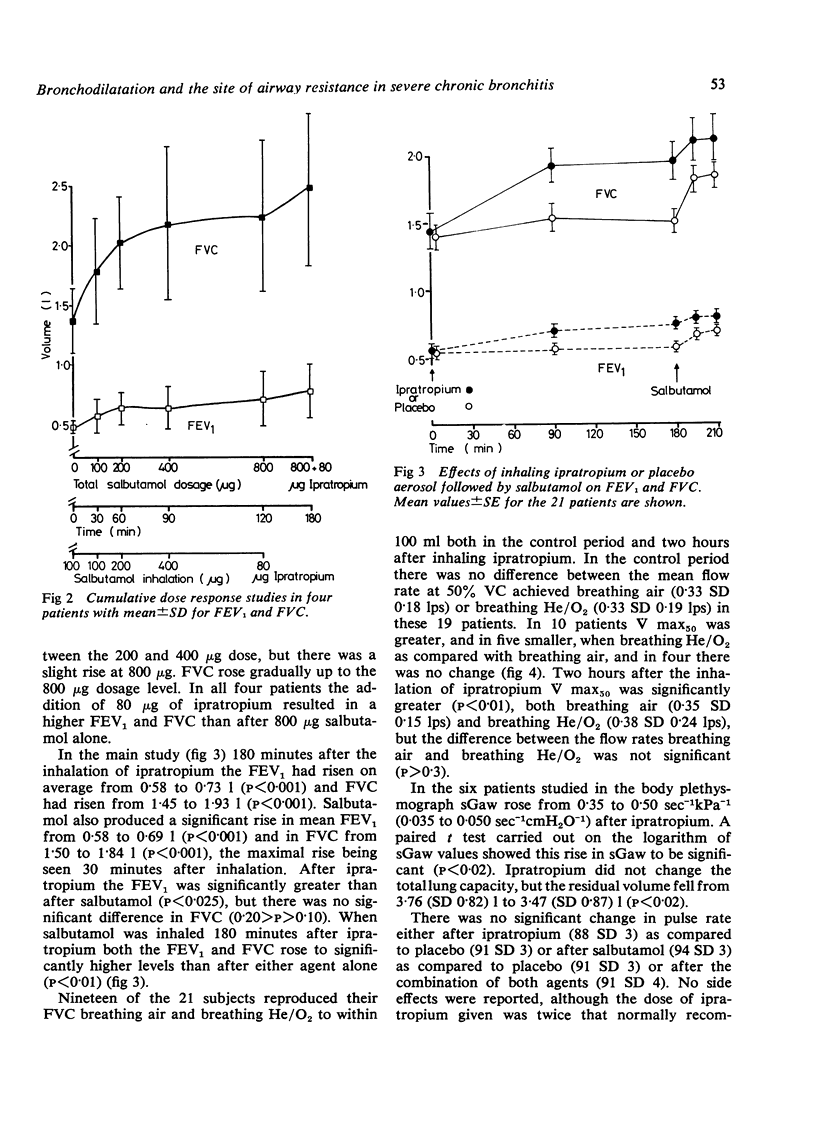Abstract
Twenty-one patients with severe chronic bronchitis and emphysema (FEV1 less than 1 1) inhaled 80 microgram of the atropine-like agent ipratropium or placebo in a double-blind study and three hours later inhaled 200 microgram salbutamol. After 80 microgram ipratropium, mean FEV1 was significantly greater than after 200 microgram salbutamol (P less than 0.025), but the difference was only 40 ml and the clinical significance of this difference is unproved. There was no correlation between the patient's response to ipratropium and the response to salbutamol. When salbutamol was administered three hours after ipratropium, the FEV1 rose to higher levels than after either agent alone (P less than 0.01). Studies breathing 80% helium/20% oxygen suggest that ipratropium dilates both large and small airways. There was no correlation between the response to helium/oxygen and the response to either bronchodilator. The results suggest that in severe chronic bronchitis and emphysema ipratropium is at least as effective as salbutamol, and that such patients should have reversibility studies with salbutamol alone, ipratropium alone, and after both agents together. The combination of ipratropium and salbutamol may be clinically useful.
Full text
PDF





Selected References
These references are in PubMed. This may not be the complete list of references from this article.
- ALTOUNYAN R. E. VARIATION OF DRUG ACTION ON AIRWAY OBSTRUCTION IN MAN. Thorax. 1964 Sep;19:406–415. doi: 10.1136/thx.19.5.406. [DOI] [PMC free article] [PubMed] [Google Scholar]
- Benatar S. R., Clark T. J., Cochrane G. M. Clinical relevance of the flow rate response to low density gas breathing in asthmatics. Am Rev Respir Dis. 1975 Feb;111(2):126–134. doi: 10.1164/arrd.1975.111.2.126. [DOI] [PubMed] [Google Scholar]
- Cabezas G. A., Graf P. D., Nadel J. A. Sympathetic versus parasympathetic nervous regulation of airways in dogs. J Appl Physiol. 1971 Nov;31(5):651–655. doi: 10.1152/jappl.1971.31.5.651. [DOI] [PubMed] [Google Scholar]
- Despas P. J., Leroux M., Macklem P. T. Site of airway obstruction in asthma as determined by measuring maximal expiratory flow breathing air and a helium-oxygen mixture. J Clin Invest. 1972 Dec;51(12):3235–3243. doi: 10.1172/JCI107150. [DOI] [PMC free article] [PubMed] [Google Scholar]
- Engel L. A., Landau L., Taussig L., Martin R. R., Sybrecht G. Influence of bronchomotor tone on regional ventilation distribution at residual volume. J Appl Physiol. 1976 Mar;40(3):411–416. doi: 10.1152/jappl.1976.40.3.411. [DOI] [PubMed] [Google Scholar]
- HERXHEIMER H. Atropine cigarettes in asthma and emphysema. Br Med J. 1959 Aug 15;2(5145):167–171. doi: 10.1136/bmj.2.5145.167. [DOI] [PMC free article] [PubMed] [Google Scholar]
- Hossain S., Heard B. E. Hyperplasia of bronchial muscle in chronic bronchitis. J Pathol. 1970 Jun;101(2):171–184. doi: 10.1002/path.1711010212. [DOI] [PubMed] [Google Scholar]
- Palmer K. N., Diament M. L. Dynamic and static lung volumes and blood-gas tensions in bronchial asthma. Lancet. 1969 Mar 22;1(7595):591–593. doi: 10.1016/s0140-6736(69)91531-1. [DOI] [PubMed] [Google Scholar]
- Pedley T. J., Schroter R. C., Sudlow M. F. The prediction of pressure drop and variation of resistance within the human bronchial airways. Respir Physiol. 1970 Jun;9(3):387–405. doi: 10.1016/0034-5687(70)90094-0. [DOI] [PubMed] [Google Scholar]
- Petrie G. R., Palmer K. N. Comparison of aerosol ipratropium bromide and salbutamol in chronic bronchitis and asthma. Br Med J. 1975 Feb 22;1(5955):430–432. doi: 10.1136/bmj.1.5955.430. [DOI] [PMC free article] [PubMed] [Google Scholar]
- Poppius H., Salorinne Y. Comparative trial of a new anticholinergic bronchodilator, Sch 1000, and salbutamol in chronic bronchitis. Br Med J. 1973 Oct 20;4(5885):134–136. doi: 10.1136/bmj.4.5885.134. [DOI] [PMC free article] [PubMed] [Google Scholar]
- Stanescu D. C., De Sutter P., Van De Woestijne K. P. Pressure-corrected flow body plethysmograph. Am Rev Respir Dis. 1972 Feb;105(2):304–305. doi: 10.1164/arrd.1972.105.2.304. [DOI] [PubMed] [Google Scholar]
- Storms W. W., DoPico G. A., Reed C. E. Aerosol Sch 1000. An anticholinergic bronchodilator. Am Rev Respir Dis. 1975 Apr;111(4):419–422. doi: 10.1164/arrd.1975.111.4.419. [DOI] [PubMed] [Google Scholar]
- Wellman J. J., McFadden E. R., Jr, Ingram R. H., Jr Density-dependence of maximal expiratory flow rates before and after bronchodilators in patients with obstructive airways disease. Clin Sci Mol Med. 1976 Aug;51(2):133–139. doi: 10.1042/cs0510133. [DOI] [PubMed] [Google Scholar]
- Yu D. Y., Galant S. P., Gold W. M. Inhibition of antigen-induced bronchoconstriction by atropine in asthmatic patients. J Appl Physiol. 1972 Jun;32(6):823–828. doi: 10.1152/jappl.1972.32.6.823. [DOI] [PubMed] [Google Scholar]


